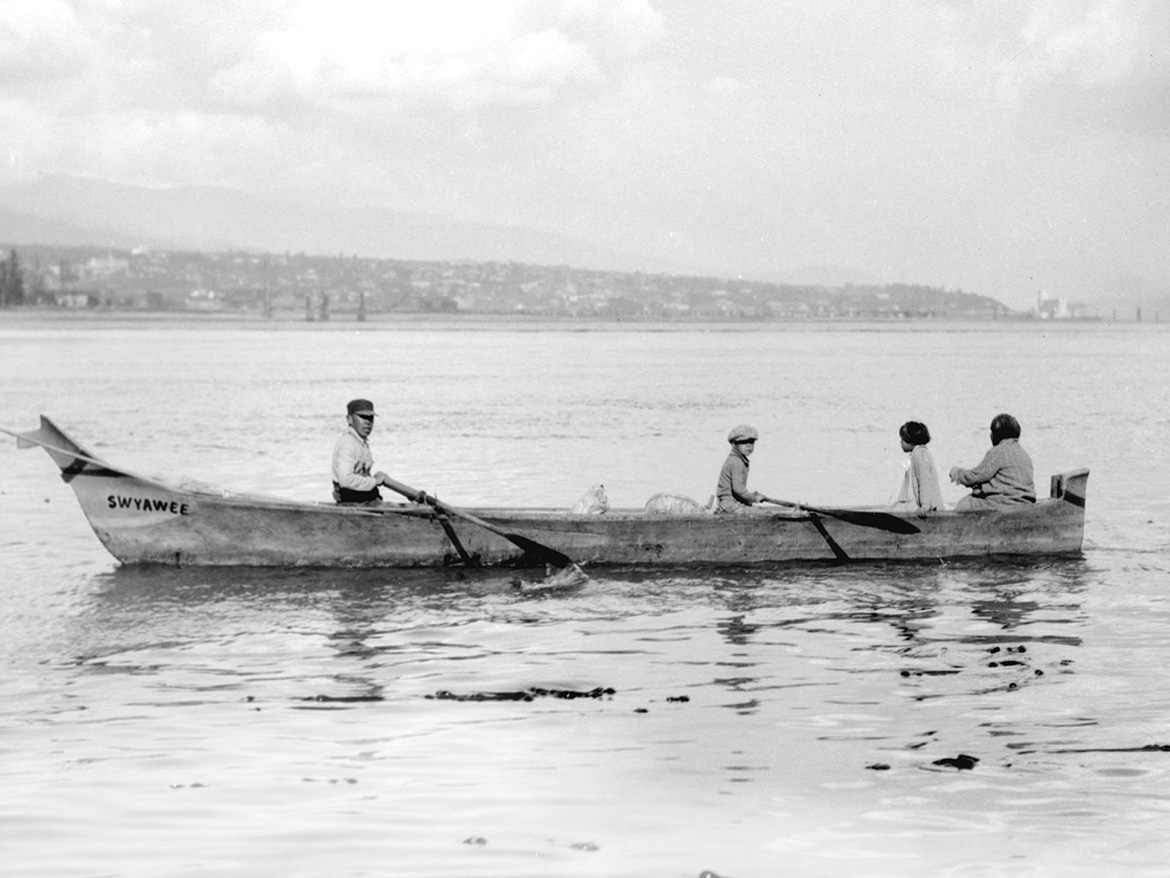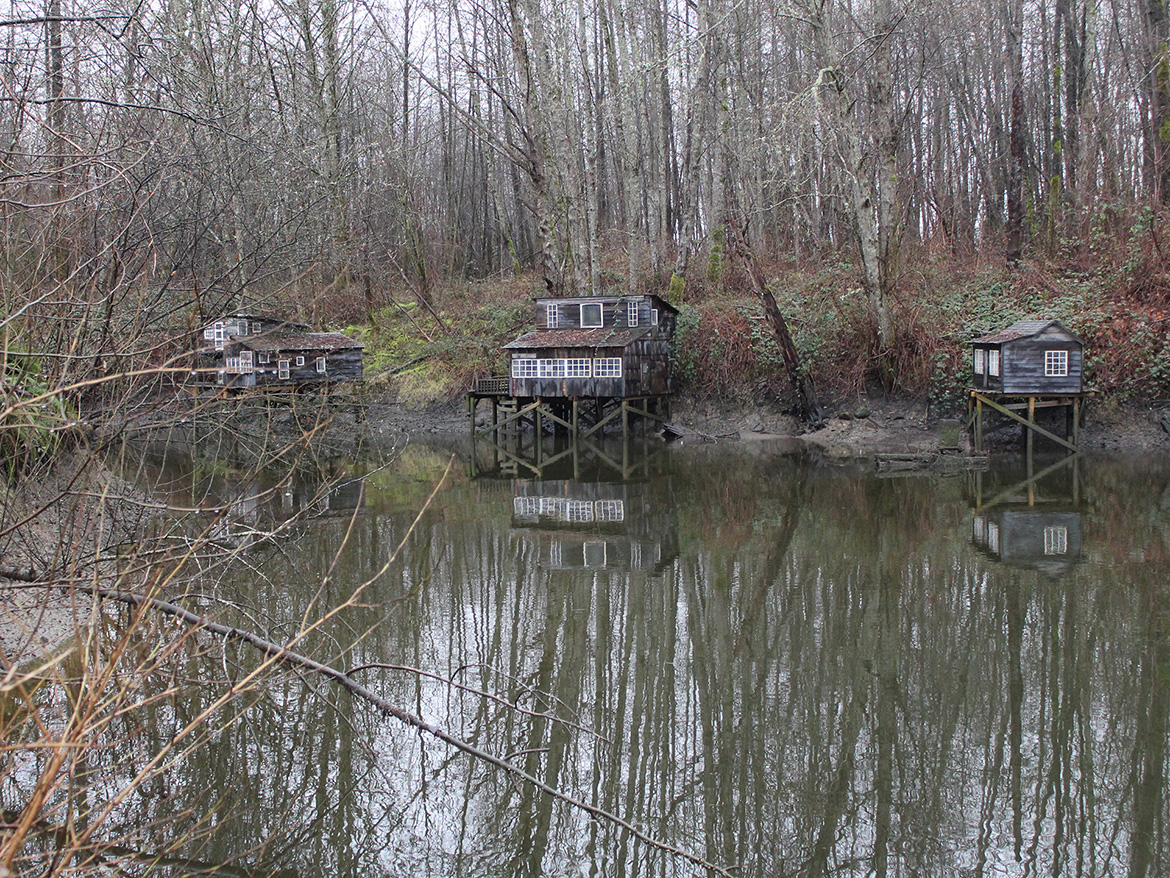History of the Region
The Tsleil-Waututh Nation (səlilwətaɬ), ‘The People of the Inlet’, have inhabited what is now known as Dollarton, Cates Park, and a large part of the Burrard Inlet shore for millennia. Some ten thousand people are believed to have lived in the area, setting up camps and erecting their summer houses along the foreshore in the late spring as part of their seasonal round. The village of Whey-ah-Wichen (‘facing the wind’) was located in the present Cates Park. 1

Image: Stuart Thompson, Indian dugout canoe on Burrard Inlet, 1930 (City of Vancouver Archives)
Coast Salish people were active managers of the region’s ecologies and made conscious decisions and actions to promote the future health and abundance of these resources. This concept is most simply described as a stewardship ethic. 2

Sande Waters, Blue Cabin, 2015
In the late 19th and early 20th century, communities existed at several sites near Stanley Park – including Deadman’s Island and Coal Harbour – and along Burrard Inlet, including the foreshore at the Kitsilano Reserve (now under Burrard Bridge), Brighton Beach and “Crabtown,” close to the Ironworkers Memorial Bridge.
On the North Shore, several clusters of squatter cabins dotted the foreshore where Cates Park was later established in 1950. One, known as Lazy Bay, had over 90 structures at that time. This is where Malcolm Lowry produced his novel Under the Volcano.3
Further west was the Maplewood Mudflats, where a settlement of squatters was expelled in 1961, and where a brief resurgence of shoreline squatting by hippies, artists, musicians, and other counterculture figures in the late 1960s was burnt out by the forces of law and order in the early 1970s. Artist Tom Burrows took up residence on the Maplewood Mudflats around that time, as did neuroscientist and then Greenpeace activist, and founder of OrcaLab, Dr. Paul Spong.4
Director Robert Altman’s McCabe and Mrs. Miller was filmed on the Maplewood Mudflats in 1970. Altman employed a number of the local squatters as extras and set builders.5

Image: Karlene Harvey, From Shangri-la to Shangri-la by Ken Lum, 2015.
From 1932 to 2015, the Blue Cabin sat in a cove on the western boundary of Cates Park, about a mile up from the Maplewood Mudflats. The land adjacent to the cabin came to be used for shipbuilding and other marine industries, principally by McKenzie Barge & Derrick Co., Ltd. (later McKenzie Barge and Marine Ways Ltd.) and the Dollarton Shipyard. McKenzie Barge, who established their Dollarton shipyard in 1932, would have owned the land to the high-water mark, as dictated by BC property law.6
- Harold Kalman & Andrew Todd Conservators Limited, ‘A Plan for the Conservation and Re-use of the Blue Cabin’, Page 5, December 2015.
- Morin, Gord, ‘Tsleil-Waututh Nation’s History, Culture and Aboriginal Interests in Eastern Burrard Inlet’, redacted version. Prepared for Gowling Lafleur Henderson LLP, Toronto. May 25, 2015, cited in Cole Projects, ‘Blue Cabin Floating Artist Residency Preliminary Feasibility Report’, Page 21, August 2016.
- Paragraphs 3, 4 and 5 adapted from: Tom Sandborn. ‘A history of Vancouver squats’, The Vancouver Sun. January 24, 2015.
- Kevin Griffin, ‘Tom Burrows & the mythology of the Maplewood Mudflats squatter community’, The Vancouver Sun. January 9, 2015.
- John Goodman, ‘Boot and Fog: Robert Altman kept his distance from Old Hollywood’, North Shore News, November 7, 2014.
- Harold Kalman & Andrew Todd Conservators Limited, ‘A Plan for the Conservation and Re-use of the Blue Cabin’, Page 7, December 2015. McKenzie Barge & Derrick Co., Ltd. is recorded as established in 1932 in shipbuilding archives, available here: http://shipbuildinghistory.com/canadayards/mckenzie.htm